Greenock, Inverclyde, Scotland, UK 作者: 来源: 发布时间:2021-07-29
I. Population and Area
Continent: Europe
Country: The U.K
State/Province: Scotland
City/Town: Greenock,Inverclyde
Total Area: 4.9 (sq mi)
Population in 2018: 42.00 (thousand)

II. Natural Geography (environment and resources)
Areas and suburbs
Arran View, Bogston, Bow Farm, Braeside, Branchton, Bridgend, Broomhill, Cartsburn, Cornhaddock, Fancy Farm, Fort Matilda, Gibshill, Greenock West, Grieve Hill, Hole Farm, Larkfield, Lyle Hill, Lynedoch, Overton, Pennyfern, Strone, Strone Farm and Whinhill. Spango Valley is located to the west of the town.
Rail
Greenock is Scotland's best served town in terms of railway stations. It boasts eight: Bogston, Cartsdyke, Greenock Central, Greenock West, Fort Matilda, Whinhill, Drumfrochar and Branchton. A ninth station, located at the former IBM complex, is currently mothballed pending redevelopment of the site. Only Glasgow has a much greater number of stations and Edinburgh possesses only two more. Greenock has the longest bored railway tunnel in Scotland at 1.2 miles (1.9 km) in length. Located directly under Newton Street in the town, the tunnel allowed for the extension of the railway to Gourock.
Bus
Greenock is served by a number of local bus routes covering the majority of Greenock, Gourock and Port Glasgow. Long-distance services travel regularly to Glasgow, Largs and Dunoon. The majority of routes are run by McGill's Bus Services. The Largs to Glasgow corridor is served by two services, the 901, 906, which provide a bus along this route every 15 minutes for most of the day. The 531 service also offers travel from Greenock to Glasgow, serving the Slaemuir area of Port Glasgow before connecting with the X7 Service and continuing through Bridge of Weir, Houston and Linwood, then joining the motorway to Braehead before heading into Glasgow City Centre.
Motorway
Greenock is located at the end of the A8 road/M8 motorway which begins in Edinburgh. It is also the northern terminus of Euroroute E05 which heads south through England, France and Spain, ending at the Spanish port and container terminal of Algeciras.
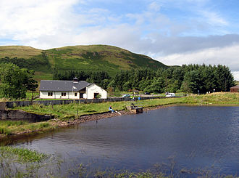
III. Economy
Average Salary in Greenock, Scotland: Inverclyde £24k


About Greenock, Scotland: Inverclyde
The average salary in Greenock, Scotland: Inverclyde is £24k. Trends in wages decreased by -100.0 percent in Q2 2020. The cost of living in Greenock, Scotland: Inverclyde is 100 percent higher than the national average. The most popular occupations in Greenock, Scotland: Inverclyde are Underwriter, Prison Officer, and Customer Service Manager which pay between £15k and £40k per year. The most popular employer in Greenock, Scotland: Inverclyde is Cigna Corporation.
About Greenock, Scotland: Inverclyde
The average salary in Greenock, Scotland: Inverclyde is £24k. Trends in wages decreased by -100.0 percent in Q2 2020. The cost of living in Greenock, Scotland: Inverclyde is 100 percent higher than the national average. The most popular occupations in Greenock, Scotland: Inverclyde are Underwriter, Prison Officer, and Customer Service Manager which pay between £15k and £40k per year. The most popular employer in Greenock, Scotland: Inverclyde is Cigna Corporation.
Reference Website:
https://www.payscale.com/research/UK/Location=Norwich-England%3A-Norfolk/Salary
IV. Industrial Characterisitics
Major industries:
Greenock became a centre of industry, with water power being used to process imported goods. In 1827 Loch Thom was constructed as a reservoir with The Cut aqueduct, bringing water to two lines of falls for water mills to power a paper mill, cotton and woollen mills, sugar refineries and shipbuilding
Greenock was shaped by heavy industries but decline in this sector meant the town had to change to meet the demands of the new electronic age and service sector industries. Greenock is now host to a variety of big name service industry providers including IBM, Toshiba, Royal Bank of Scotland Mortgage Centre, Amazon and EE who all have their UK or European bases.The harbourside areas have now been cleared to make way for modern developments like The Royal Bank of Scotland's National Mortgage Centre, a new four screen cinema complex and a state-of-the-art ice and water leisure complex.
A civic square has been created in front of the Custom House. This Grade A listed building was built in 1818, The nearby quay was the departure point for many Scottish emigrants during the 19th century, and it is now a regular stop for the world's last ocean going paddle steamer - The Waverley.
The main shopping area in Inverclyde is Greenock's Oak Mall. Although the development of Greenock has been dictated by industrial growth, the legacy of this has been a wealth of beautiful civic and domestic buildings, many of which are protected by listed building status. Cathcart Square and a large part of the west end of Greenock, including the McLean Museum and Watt Library, are also designated conservation areas to protect the historic buildings from development.
Major projects and related introductions:
City Deal
Two Inverclyde-based projects as part of the £1bn Glasgow and Clyde Valley City Deal scheme have received official approval.
For, strategic business cases for a project to improve the A78 at Inverkip and another to expand Greenock Ocean Terminal have been approved by leaders operating the City Deal across eight Scottish councils.
The Inverkip project will open up the former power station site for housing. The business case, presented to the board, was agreed and unlocks funding to develop the design phase of the project.
Reference Website:
https://www.inverclyde.gov.uk/tourism-and-visitor-attractions/things-to-see-and-do/a-quick-tour-of-inverclyde/greenock
https://www.inverclyde.gov.uk/news/2015/oct/city-deal
V. Attractions
1. Lyle Hill:
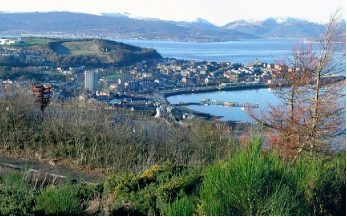
View up here is cracking. When it's clear I don't think there's a better bit of scenery in Scotland. It's just a pity that it rains a lot in the west of Scotland so most of the time it's pish! Lyle Hill was easy to find, well signposted, with parking at the top. The view is superb but we were almost blown over and couldn't stay long, sadly. If we ever go to Greenock again we'll make sure to re-visit.
2. Greenock Cut Visitor Centre:
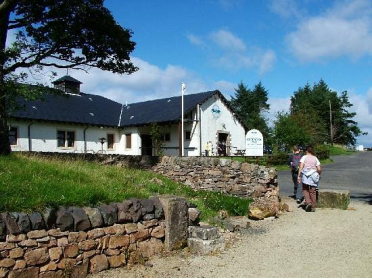
Overview
Part of Clyde Muirshiel Regional Park, Greenock Cut Visitor Centre, Loch Thom, not far from Inverkip in Inverclyde, provides wonderful walks, scenic views and picnic sites. There is good access to the Greenock Cut (a 5.5 mile aqueduct,
3. Scottish Fire and Rescue Service Museum and Heritage Centre:
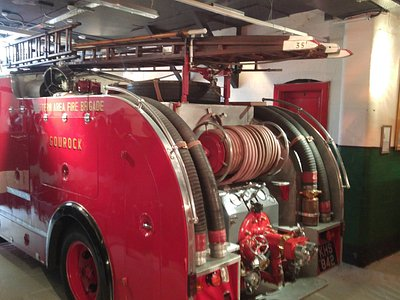
There is also a huge collection of helmets, uniforms, breathing apparatus and firefighting memorabilia together with displays on the Glasgow Fire Service and it's history. Very interesting to see the history of fire brigade a must see and do a good video to watch and lots of interesting leaflets about other places to pick up
Reference Website:
https://www.tripadvisor.com/Attractions-g186553-Activities-Greenock_Inverclyde_Scotland.html
VI. History
Name
Place-name scholar William J. Watson wrote that "Greenock is well known in Gaelic as Grianáig, dative of grianág, a sunny knoll". The Scottish Gaelic place-name Grianaig is relatively common, with another (Greenock) near Callander in Menteith (formerly in Perthshire) and yet another at Muirkirk in Kyle, now in East Ayrshire. R. M. Smith in (1921) described the alternative derivation from Common Brittonic *Graenag, a "gravelly" or "sandy place", as more appropriate, accurately describing the original foreshore. Johnston (1934) notes that "some Gaels call the seaport Ghónait", and that a possible derivation may be greannach, meaning "rough, gravelly". The name of the town has had various spellings over time. It was printed in early Acts of Parliament as Grinok, Greenhok, Grinock, Greenhoke, Greinnock, and later as Greinok. Old Presbyterial records used Grenok, a common spelling until it was changed to Greenock around 1700.
Early history: baronies and kirks
Hugh de Grenock was created a Scottish Baron in 1296, and the seat of the feudal barony of Greenock was apparently what became Easter Greenock Castle. Around 1400 his successor Malcolm Galbraith died with no sons, and his estate was divided between his two daughters to become two baronies: the eldest inherited Easter Greenock and married a Crawfurd, while Wester Greenock went to the younger daughter who married Schaw of Sauchie. Around 1540 the adjoining barony of Finnart was passed to the Schaw family, extending their holdings westward to the boundary of Gourock, and in 1542 Sir John Schaw founded Wester Greenock castle.
Fishing villages, harbours and shipbuilding
The coast of Greenock formed a broad bay with three smaller indentations: the Bay of Quick was known as a safe anchorage as far back as 1164. To its east, a sandy bay ran eastwards from the Old Kirk and the West Burn as far as Wester Greenock castle. The fishing village of Greenock developed along this bay, and around 1635 Sir John Schaw had a jetty built into the bay which became known as Sir John's Bay. In that year he obtained a Charter raising Greenock to a Burgh of Barony with rights to a weekly market. Further east, Saint Laurence Bay curved round past the Crawfurd Barony of Easter Greenock to Garvel (or Gravel) Point. When a pier (or dyke) was built making the bay an important harbour, the fishing village of Cartsdyke gained the alternative name of Crawfurdsdyke. In 1642 it was made into the Burgh of Barony of Crawfurdsdyke, and part of the ill-fated Darien Scheme set out from this pier in 1697. Its town was named Cartsburn.
Custom house and steamboats
In 1714 Greenock became a custom house port as a branch of Port Glasgow, and for a period this operated from rooms leased in Greenock. Receipts rose rapidly with the expansion of colonial trade, and in 1778 the custom house moved to new built premises at the West Quay of the harbour. By 1791 a new pier was constructed at the East Quay. In 1812 Europe's first steamboat service was introduced by PS Comet with frequent sailings between Glasgow, Greenock and Helensburgh, and as trade built up the pier became known as Steamboat Quay. The custom house needed larger premises, and in May 1817 the foundation stone was laid at the quay for a Custom House building designed by William Burn, which was completed in 1818. Its gracious neoclassical architecture features a Grecian Doric portico looking out over the quayside, which was given the name Customhouse Quay. In 1828 the Custom House was praised as "a grand National Structure" in "the highest style of elegance". By then there were scheduled steamboat sailings to Belfast, Londonderry, Liverpool, Inverness, Campbeltown, the Hebrides and "all the principal places in the Highlands".
Postwar years
Greenock thrived in the post-war years but as the heavy industries declined in the 1970s and 1980s unemployment became a major problem, and it has only been in the last ten years with reinvestment and the redevelopment of large sections of the town that the local economy has started to revive. Tourism has appeared as an unexpected bonus with the development of the Clydeport container port as Ocean Terminal, a passenger terminal for cruise ships touring the Atlantic. Students who do not travel further afield for study often attend the Greenock campus of West College (formerly known as James Watt College of Further and Higher Education).
VII. Culture
Greenock is one of the settings for Alan Sharp's 1965 novel A Green Tree in Gedde. It is fictionalised as 'Gantock' by Robin Jenkins in his 1979 novel Fergus Lamont (The Gantocks are a rocky shoal in the Firth of Clyde nearby, just off Dunoon). Alasdair Gray's 1984 novel 1982, Janine is set in a Greenock hotel room. Matthew Fitt's cyberpunk novel But'n'Ben A-Go-Go features a submerged Greenock after the effects of global warming. Greenock has featured in the poetry of W.S. Graham (evoking his childhood) and Douglas Dunn.
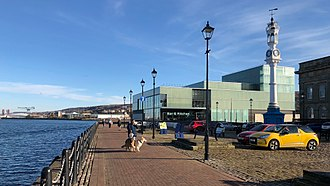
Greenock is home to the world's first Burns Club, The Mother Club, which was founded in 1801 by merchants born in Ayrshire, some of whom had known Robert Burns. They held the first Burns Supper on what they thought was his birthday on 29 January 1802, but in 1803 discovered from the Ayr parish records that the correct date was 25 January 1759.
The Victorian landscape artist John Atkinson Grimshaw depicted a somewhat idealised Greenock in several of his paintings.
The Mclean Museum is the largest museum in the Inverclyde area, featuring exhibitions on James Watt and a collection of Ancient Egyptian artefacts.
In television
The 1974 BBC Scotland adaptation of the Para Handy novels, entitled The Vital Spark, was filmed in Greenock. In 2012, Greenock became the setting for the BBC television drama Waterloo Road, after the series was relocated from Rochdale, Greater Manchester. The series was shot at Greenock Academy, a former secondary school in the west of the town.
In film
Greenock has featured as the backdrop to several films: the television films Just a Boys' Game (1979), Down Where The Buffalo Go (1988) and Down Among the Big Boys (1993) and the cinema films Sweet Sixteen (2002), Dear Frankie (2004) and Badla (2019). An early Danny Boyle film Leaving (1988) was shot here. In Rob Roy, which is set in the mid-eighteenth century, Greenock is referred to as "the port to new world".
VIII. Other information
Greenock Morton F.C. are the local senior football team who currently play in the Scottish Championship. Founded in 1874 as Morton F.C., they play their home matches at Cappielow. At lower levels of the game, Greenock Juniors F.C. play in the West of Scotland Football League. Greenock hosts a rugby union team, Greenock Wanderers RFC, founded in 1873. It is one of the oldest clubs in Scotland.
Greenock also has 2 successful athletics clubs, Inverclyde AC and Glenpark Harriers. It is also the hometown of the Greenock Cricket Club. and Greenock Golf Club, The town was also the host of the first ever international women's football match, which was between Scotland and England; it was held at the Ravenscraig Sports Centre. The engineer James Watt is the most renowned Greenockian. He is remembered in several placenames in the town, in the library instituted in his memory, and by the original Watt Memorial School (later College) building on the site of his birthplace in William Street, which incorporates a commemorative statue. The Finnart Campus of the local college was until 2014 known as the James Watt College. Wetherspoons opened the James Watt pub after the building was converted its previous use as the General Post Office.
The Lady Octavia park and sports centre are named after Lady Octavia Grosvenor, wife of the local MP Sir Michael Shaw-Stewart, who died in 1921. Other Greenockians include the composers Hamish MacCunn and William Wallace, violinist Henri Temianka, musicians John McGeoch and Thomas Leer,mathematician William Spence, poets Denis Devlin, W. S. Graham and Jean Adam, merchant Matthew Algie, actors Richard Wilson, Martin Compston and Stella Gonet, artists William Scott, Alison Watt and Frederick Donald Blake, playwrights Bill Bryden, Neil Paterson and Peter McDougall, comedian Charles 'Chic' Murray, opera singer Hugh Enes Blackmore, broadcaster Jimmy Mack, American football player Lawrence Tynes, children's theatre performer Ruairidh Forde, PGA Pro golfer Colin Robinson, Antarctic explorer Henry Robertson 'Birdie' Bowers and portrait painter Leonard Boden.
Two Greenockians, Alexander Bruce and Theophilus S. Marshall, were involved in the drafting of the laws for Australian Rules Football.
IX. Contact information
Mayor/Officer: Stephen McCabe
Tel: 01475 717171
Mail: customerservice@inverclyde.gov.uk
Reference Website:
https://www.inverclyde.gov.uk/council-and-government/contact-us
https://www.inverclyde.gov.uk/news/2019/feb/diodes-acquires-texas-instruments-greenock
